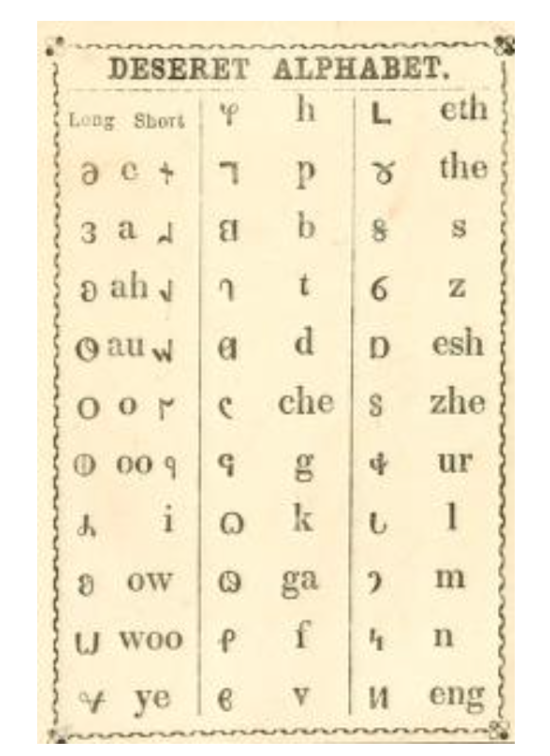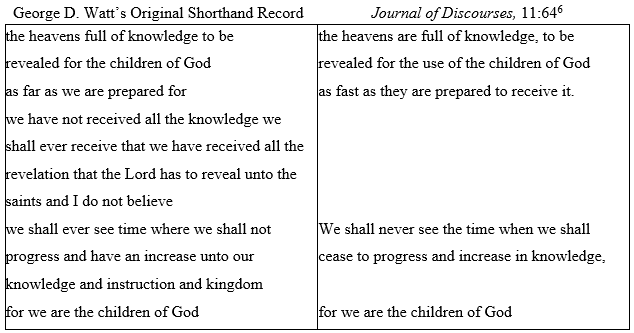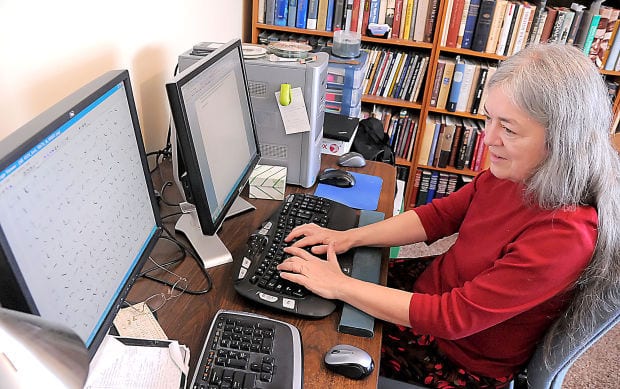The following is from LaJean Purcell Carruth’s presentation at BYU Education Week 2022 as part of the series presented on what can be learned from the Wilford Woodruff Papers.
She also gave a presentation at the 2023 FAIR Conference, which is available to watch on our YouTube channel.
Introduction
When she was eleven years old, LaJean Purcell Carruth found an old Improvement Era in her parents’ basement open to an article on the Deseret Alphabet.1 She was instantly, completely fascinated. She taught herself to read and write the Deseret Alphabet and decided that she would be a Deseret transcriber when she grew up. Little did she know where that early passion would lead.

As a graduate student at BYU in 1974, LaJean was hired to transcribe Deseret Alphabet entries in Wilford Woodruff’s journals, which fulfilled, in part, her childhood ambition. She also taught herself to read 19th-century Pitman shorthand, then began to translate the shorthand records in Wilford’s journals. As she transcribed these records, she discovered that Wilford Woodruff actually wrote in two types of shorthand: Pitman shorthand, published by Isaac Pitman in 1837, and Taylor shorthand, published by Samuel Taylor in 1786.

Wilford Woodruff’s Shorthand Writing

Elder Hale and myself had a good time in secret prayer. May God bless us on the islands and help us find the blood of Ephraim.
Note: Shorthand is in bold type and longhand is in regular type.
Wilford wrote some words in shorthand for convenience, especially frequently written phrases such as “distance of the day,” and “took the parting hand.”
Some of his shorthand entries are spiritual and very personal. In this example, Wilford recorded in shorthand part of a blessing he received when he was ordained a Seventy, detailing what must have been a very spiritual experience:

YEA even when my spirit was playing around the throne of God in eternity that I should travel to the nations of the Earth & the Islands of the sea to Proclaim the word of God when these and other blessings were Pronounced upon my head I was filled with the Power & spirit of God EVEN SO LET IT BE AMEN.
Another example from his mission to the Southern States:

I and Brothers Smoot and Clapp went to the woods to pray. the power of God sat on us. we prayed with the spirit of prophecy. I sealed up my brethren and prophesied on their heads great blessings by the spirit of God.
Another personal spiritual experience:

I was still sick in the morning I had Prayers & was much better after my wife laid hands on me and asked the Lord to heal me.
Wilford Woodruff’s Sermons Reported by Other Shorthand Writers
Many of Wilford’s sermons were recorded in Pitman shorthand by other shorthand reporters, including George D. Watt. However, as Watt later translated his shorthand records for publication, he frequently changed the words: he added text that wasn’t in the shorthand, he took out text that was in the shorthand, and he rewrote some passages. (This is what shorthand reporters did at the time; their ideas of accuracy were very different from ours.) Because of this, much of what was published from those shorthand records in the Journal of Discourses and the Deseret News is not what was actually said. Here is one example from a sermon by Wilford Woodruff on June 27, 1875:

The Lost Sermons: Never Transcribed or Published
The shorthand record of many sermons by early Church leaders was never transcribed. As LaJean began transcribing Wilford Woodruff’s previously untranscribed sermons, she began to learn much about him—about how he spoke, about the great dignity with which he spoke, and about his personal experiences, especially regarding the gospel.
From George Watt’s shorthand, LaJean recently transcribed this account from Wilford Woodruff’s record:
I even prayed before the Lord from time to time that I might live to behold a people who again embraced those principles and blessings I saw an account of recorded in the Bible . . . The Spirit of God bore record to me in my labors from time to time I [would] live to see that day that I should occupy a place in house of God behold a people who again embraced the gospel of Christ.7
She also recently transcribed this unpublished record written in shorthand by John V. Long, another shorthand reporter:
The Lord requires a great many things of us and the greater our blessings the greater will be our responsibilities to the Lord. The Lord will hold us responsible for all the blessings that he has given unto us he will hold us responsible for the gospel which he has revealed unto us, for the use we make he will hold us responsible for the holy priesthood and the use we make of that and he will hold us responsible [for] all the truths of light and faith that has been given unto this people . . . It is a comfort to know that we serve a God whose attributes are good and righteous and to establish righteousness and truth upon the earth to do his mind and will to accomplish things necessary for the redemption of the earth for this reign and reign of his Son Jesus Christ and the saints.8
Conclusion
These shorthand records enable us to have a more accurate view of early Church leaders like Wilford Woodruff. We can read the actual words he spoke and grow to understand the kind of person he was. But we also need to understand that some shorthand sources, like those published by George D. Watt, might be inaccurate. When we look more deeply into true and accurate sources from Church history, we can discover that this is the Church of Jesus Christ. Wilford Woodruff knew that this was Christ’s Church as soon as he found it. We can learn much from him and his willingness to search for truth.
Endnotes
- To learn more about the Deseret Alphabet, read “Deseret Alphabet,” Church History Topics, ChurchofJesusChrist.org.
- Wilford Woodruff’s Journal, August 20, 1837, p. 170, The Wilford Woodruff Papers, accessed August 16, 2023, wilfordwoodruffpapers.org/journal/1837-08-20.
- Wilford Woodruff’s Journal, May 31, 1836, p. 85, The Wilford Woodruff Papers, accessed August 16, 2023, wilfordwoodruffpapers.org/journal/1836-05-31.
- Wilford Woodruff’s Journal, June 30, 1836, p. 90, The Wilford Woodruff Papers, accessed August 16, 2023, wilfordwoodruffpapers.org/journal/1836-06-30.
- Wilford Woodruff’s Journal, March 30, 1838, p. 25, The Wilford Woodruff Papers, accessed August 16, 2023, wilfordwoodruffpapers.org/journal/1838-03-30.
- Discourse by Wilford Woodruff, June 27, 1875, p. 1, The Wilford Woodruff Papers, accessed August 17, 2023, wilfordwoodruffpapers.org/discourse/1875-06-27.
- Church History Department Pitman Shorthand transcriptions, Wilford Woodruff, 1860–1872, April 6, 1860, ChurchofJesusChrist.org.
- Church History Department Pitman Shorthand transcriptions, Wilford Woodruff, 1860–1872, August 22, 1863, ChurchofJesusChrist.org.
 LaJean Purcell Carruth is a senior historian at the Church History Library in Salt Lake City and an Advisor to the Wilford Woodruff Papers Project. She is the coeditor of Mountain Meadows Massacre: Collected Legal Papers (2017) and Liverpool to Great Salt Lake: The 1851 Journal of Missionary George D. Watt (2022).
LaJean Purcell Carruth is a senior historian at the Church History Library in Salt Lake City and an Advisor to the Wilford Woodruff Papers Project. She is the coeditor of Mountain Meadows Massacre: Collected Legal Papers (2017) and Liverpool to Great Salt Lake: The 1851 Journal of Missionary George D. Watt (2022).
To learn more about the Restoration of the gospel of Jesus Christ and the never-before-published history of The Church of Jesus Christ of Latter-day Saints, please visit wilfordwoodruffpapers.org.
